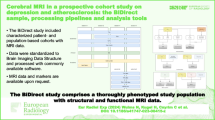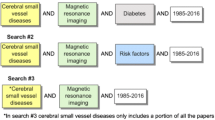Abstract
Objectives
To describe the implementation and protocol of cerebral magnetic resonance imaging (MRI) in the longitudinal BiDirect study and to report rates of study participation as well as management of incidental findings.
Methods
Data came from the BiDirect study that investigates the relationship between depression and arteriosclerosis and comprises 2258 participants in three cohorts: 999 patients with depression, 347 patients with manifest cardiovascular disease (CVD) and 912 population-based controls. The study program includes MRI of the brain. Reasons for non-participation were systematically collected. Incidental findings were categorized and disclosed according to clinical relevance.
Results
At baseline 2176 participants were offered MRI, of whom 1453 (67 %) completed it. Reasons for non-participation differed according to cohort, age and gender with controls showing the highest participation rate of 79 %. Patient cohorts had higher refusal rates and CVD patients a high prevalence of contraindications. In the first follow-up examination 69 % of participating subjects completed MRI.
Incidental findings were disclosed to 246 participants (17 %). The majority of incidental findings were extensive white matter hyperintensities requiring further diagnostic work-up.
Conclusions
Knowledge about subjects and sensible definition of incidental findings are crucial for large-scale imaging projects. Our data offer practical and concrete information for the design of future studies.
Key points
• Willingness to participate in MRI is generally high, also in follow-up examinations.
• Rates of refusal and prevalence of contraindications differ according to subject characteristics.
• Extensive white matter hyperintensities considerably increase the disclosure rates of incidental findings.
• MRI workflow requires continuous case-by-case handling by an interdisciplinary team.
Similar content being viewed by others
Abbreviations
- BL:
-
Baseline
- CI:
-
Contraindication
- CVD:
-
Cardiovascular disease
- fMRI:
-
Functional magnetic resonance imaging
- FU:
-
Follow-up
- IF:
-
Incidental finding
- MRI:
-
Magnetic resonance imaging
- OR:
-
Odds ratio
- rs-fMRI:
-
Resting-state functional magnetic resonance imaging
- WMH:
-
White matter hyperintensity
References
John U, Greiner B, Hensel E et al (2001) Study of health in Pomerania (SHIP): a health examination survey in an east German region: objectives and design. Soz Praventivmed 46:186–194
Bamberg F, Kauczor H-U, Weckbach S et al (2015) Whole-body MR imaging in the German National Cohort: rationale, design, and technical background. Radiology 277:206–220
The UK Biobank Imaging Study (2015) Available via http://imaging.ukbiobank.ac.uk. http://imaging.ukbiobank.ac.uk. Accessed 4 Sep 2015
Nooner KB, Colcombe SJ, Tobe RH et al (2012) The NKI-Rockland sample: a model for accelerating the pace of discovery science in psychiatry. Front Neurosci 6:152
van Norden AG, de Laat KF, Gons RA et al (2011) Causes and consequences of cerebral small vessel disease. The RUN DMC study: a prospective cohort study. Study rationale and protocol. BMC Neurol 11:29
Geerlings MI, Appelman APA, Vincken KL et al (2010) Brain volumes and cerebrovascular lesions on MRI in patients with atherosclerotic disease. The SMART-MR study. Atherosclerosis 210:130–136
Viswanathan A, Guichard J-P, Gschwendtner A et al (2006) Blood pressure and haemoglobin A1c are associated with microhaemorrhage in CADASIL: a two-centre cohort study. Brain 129:2375–2383
Teismann H, Wersching H, Nagel M et al (2014) Establishing the bidirectional relationship between depression and subclinical arteriosclerosis - rationale, design, and characteristics of the BiDirect study. BMC Psychiatry 14:174
Hegenscheid K, Kühn J, Völzke H, Biffar R, Hosten N, Puls R (2009) Whole-body magnetic resonance imaging of healthy volunteers: pilot study results from the population-based SHIP study. RoFo 181:748–759
Rimol LM, Hartberg CB, Nesvåg R et al (2010) Cortical thickness and subcortical volumes in schizophrenia and bipolar disorder. Biol Psychiatry 68:41–50
Schmidt R, Launer LJ, Nilsson L-G et al (2004) Magnetic resonance imaging of the brain in diabetes the cardiovascular determinants of dementia (CASCADE) study. Diabetes 53:687–692
Ikram MA, van der Lugt A, Niessen WJ et al (2011) The Rotterdam scan study: design and update up to 2012. Eur J Epidemiol 26:811–824
Hofman A, Murad SD, van Duijn CM et al (2013) The Rotterdam study: 2014 objectives and design update. Eur J Epidemiol 28:889–926
DeCarli C, Massaro J, Harvey D et al (2005) Measures of brain morphology and infarction in the framingham heart study: establishing what is normal. Neurobiol Aging 26:491–510
3C Study Group (2003) Vascular factors and risk of dementia: design of the three-city study and baseline characteristics of the study population. Neuroepidemiology 22:316–325
Godin O, Dufouil C, Maillard P et al (2008) White matter lesions as a predictor of depression in the elderly: the 3C-Dijon study. Biol Psychiatry 63:663–669
Schmidt R, Fazekas F, Kapeller P, Schmidt H, Hartung H-P (1999) MRI white matter hyperintensities: three-year follow-up of the Austrian stroke prevention study. Neurology 53:132–132
Baune BT, Roesler A, Knecht S, Berger K (2009) Single and combined effects of cerebral white matter lesions and lacunar infarctions on cognitive function in an elderly population. J Gerontol A Biol Sci Med Sci 64A:118–124
Qiu C, Cotch MF, Sigurdsson S et al (2012) Cerebral microbleeds and age-related macular degeneration: the AGES-Reykjavik study. Neurobiol Aging 33:2935–2937
de Mutsert R, den Heijer M, Rabelink TJ et al (2013) The Netherlands epidemiology of obesity (NEO) study: study design and data collection. Eur J Epidemiol 28:513–523
Schulz R, Beach SR, Ives DG, Martire LM, Ariyo AA, Kop WJ (2000) Association between depression and mortality in older adults: the cardiovascular health study. Arch Intern Med 160:1761–1768
Yue NC, Longstreth WT, Elster AD, Jungreis CA, O’Leary DH, Poirier VC (1997) Clinically serious abnormalities found incidentally at MR imaging of the brain: data from the cardiovascular health study. Radiology 202:41–46
Morris Z, Whiteley WN, Longstreth WT et al (2009) Incidental findings on brain magnetic resonance imaging: systematic review and meta-analysis. BMJ 339:b3016
Hegenscheid K, Seipel R, Schmidt CO et al (2012) Potentially relevant incidental findings on research whole-body MRI in the general adult population: frequencies and management. Eur Radiol 23:816–826
Leung L (2012) Incidental findings in neuroimaging: ethical and medicolegal considerations. Neurosci J 2013:e439145
Illes J, Kirschen MP, Edwards E et al (2008) Practical approaches to incidental findings in brain imaging research. Neurology 70:384–390
Shoemaker JM, Holdsworth MT, Aine C et al (2011) A practical approach to incidental findings in neuroimaging research. Neurology 77:2123–2127
Wolf SM, Lawrenz FP, Nelson CA et al (2008) Managing incidental findings in human subjects research. J Law Med Ethics 36:219–211
Müllerleile K (2015) Passive cardiovascular implants in magnetic resonance imaging. Statement of the German Cardiac Society on the safety of magnetic resonance imaging. Kardiologe 9:303
Vernooij MW, Ikram MA, Tanghe HL et al (2007) Incidental findings on brain MRI in the general population. N Engl J Med 357:1821–1828
Debette S, Markus HS (2010) The clinical importance of white matter hyperintensities on brain magnetic resonance imaging: systematic review and meta-analysis. BMJ 341:c3666
Schmidt CO, Hegenscheid K, Erdmann P et al (2012) Psychosocial consequences and severity of disclosed incidental findings from whole-body MRI in a general population study. Eur Radiol 23:1343–1351
Acknowledgments
We would like to thank all study participants for their time and engagement. Further words of gratitude are owed to each and everyone who tirelessly contributes to cope with organisational challenges, data collection, data maintenance and data processing on a daily basis. The scientific guarantor of this publication is Klaus Berger. The authors of this manuscript declare relationships with the following companies: Klaus Berger reports grants from the German Federal Ministry of Education and Research (BMBF) and multiple institutions outside of the submitted work.
The remaining authors (Anja Teuber, Benedikt Sundermann, Harald Kugel, Walter Heindel, Jens Minnerup, Udo Dannlowski and Heike Wersching) of this manuscript declare no relationships with any companies whose products or services may be related to the subject matter of the article.
This study has received funding from the German Federal Ministry of Education and Research (BMBF, grants FKZ-01ER0816 and FKZ-01ER1205). Several authors (Anja Teuber, Klaus Berger, Heike Wersching) have significant statistical expertise. Institutional review board approval was obtained. Written informed consent was obtained from all subjects (patients) in this study. Some study subjects or cohorts have been previously reported in BMC Psychiatry (2014) 14:174. Methodology: prospective, observational, performed at one institution
Author information
Authors and Affiliations
Corresponding author
Electronic supplementary material
Below is the link to the electronic supplementary material.
ESM 1
(DOCX 303 kb)
Rights and permissions
About this article
Cite this article
Teuber, A., Sundermann, B., Kugel, H. et al. MR imaging of the brain in large cohort studies: feasibility report of the population- and patient-based BiDirect study. Eur Radiol 27, 231–238 (2017). https://doi.org/10.1007/s00330-016-4303-9
Received:
Revised:
Accepted:
Published:
Issue Date:
DOI: https://doi.org/10.1007/s00330-016-4303-9




